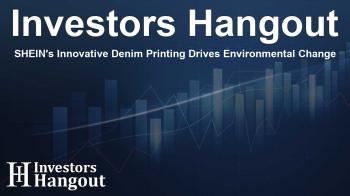SHEIN's Innovative Denim Printing Drives Environmental Change

SHEIN's Denim Transformation through Cool Transfer Printing
In a remarkable shift within the fashion industry, SHEIN is leading the charge in sustainable production practices by ramping up its use of Cool Transfer Denim Printing technology. This innovative method is not only enhancing the denim pieces coming off the production lines but also significantly reducing water and energy consumption compared to traditional methods.
Efficiency and Environmental Benefits
In 2024, SHEIN successfully produced approximately 380,000 denim apparel items using this groundbreaking technology. This represents a staggering 90% increase from the previous year, where only 200,000 pieces were made with Cool Transfer techniques. Additionally, this shift resulted in the conservation of over 10,000 metric tons of water, showcasing the effectiveness of the company's sustainable practices.
Significant Water Savings
Since incorporating Cool Transfer Denim Printing into their operations in 2022, SHEIN has managed to save nearly 19,500 metric tons of water, further underscoring their commitment to environmental stewardship. The reduction in resource usage is pivotal, considering that denim manufacturing has been dubbed a resource-intensive process traditionally.
Collaboration for Sustainability
Recognizing the environmental challenges posed by conventional denim production, SHEIN partnered with NTX® in 2021. This collaboration aimed to streamline production while minimizing ecological impact. The Cool Transfer Denim Printing process employs a digital printer that uses reactive ink to transfer designs onto denim fabric, requiring significantly less water than traditional dyeing methods.
Technology at Work
This cutting-edge technique allows for intricate designs and effects, providing a boutique feel to mass-produced denim. The process not only replicates looks associated with traditional washing methods but does so while utilizing 70.5% less water. As verified by industry standards, these advancements mark a substantial improvement over previous methods.
Enhancing Worker Safety
One of the critical advantages of Cool Transfer Denim Printing is the elimination of harmful chemicals used in traditional production methods. By minimizing workers' exposure to toxic substances like chlorine and caustic soda, SHEIN is dedicated to ensuring safer working conditions as part of its ethical production strategy.
On-demand Production Aligned with Innovation
The introduction of Cool Transfer Denim Printing complements SHEIN's on-demand production model. This model reflects a responsive approach to manufacturing, enabling the company to align production quantities closely with actual customer demand. By launching initial batches of 100-200 items, SHEIN can adapt based on customer feedback, thereby minimizing waste through overproduction.
Meeting Customer Preferences
The ability to quickly adjust production runs facilitates the design of trendy denim pieces tailored to current consumer preferences. This model not only supports sustainability by reducing excess inventory but also aligns perfectly with the capabilities of Cool Transfer technology.
Pushing Creative Boundaries
The benefits of this innovative printing process extend beyond efficiency and sustainability. It empowers SHEIN's design teams by enabling the production of complex and vibrant prints, unlocking endless creative potential. Designers can experiment with various denim textures and effects, opening pathways to unique fashion statements that reflect diverse customer aesthetics.
The Future of Denim Fashion
SHEIN's commitment to improving manufacturing processes through Cool Transfer Denim Printing exemplifies a broader ambition to advance sustainable practices within the fashion industry. By embracing technology, SHEIN is poised to lead the way toward a more resource-efficient and innovative future for fashion.
Frequently Asked Questions
What is Cool Transfer Denim Printing?
Cool Transfer Denim Printing is an innovative method that uses reactive ink and a transfer film to reduce water and energy usage in denim production.
How much water does SHEIN save using this technology?
SHEIN has saved approximately 10,000 metric tons of water in 2024 alone, marking a significant reduction in resource consumption.
What safety benefits does this process provide for workers?
The technology minimizes harmful chemical exposure, promoting safer working conditions in the denim manufacturing process.
How does SHEIN's on-demand model work?
SHEIN produces initial small batches of denim items and adjusts production based on real-time customer feedback, reducing waste and overproduction.
What creative opportunities does Cool Transfer provide for designers?
It allows designers to create vibrant, intricate prints, pushing the boundaries of traditional denim designs and meeting diverse customer preferences.
About Investors Hangout
Investors Hangout is a leading online stock forum for financial discussion and learning, offering a wide range of free tools and resources. It draws in traders of all levels, who exchange market knowledge, investigate trading tactics, and keep an eye on industry developments in real time. Featuring financial articles, stock message boards, quotes, charts, company profiles, and live news updates. Through cooperative learning and a wealth of informational resources, it helps users from novices creating their first portfolios to experts honing their techniques. Join Investors Hangout today: https://investorshangout.com/
Disclaimer: The content of this article is solely for general informational purposes only; it does not represent legal, financial, or investment advice. Investors Hangout does not offer financial advice; the author is not a licensed financial advisor. Consult a qualified advisor before making any financial or investment decisions based on this article. The author's interpretation of publicly available data shapes the opinions presented here; as a result, they should not be taken as advice to purchase, sell, or hold any securities mentioned or any other investments. The author does not guarantee the accuracy, completeness, or timeliness of any material, providing it "as is." Information and market conditions may change; past performance is not indicative of future outcomes. If any of the material offered here is inaccurate, please contact us for corrections.
